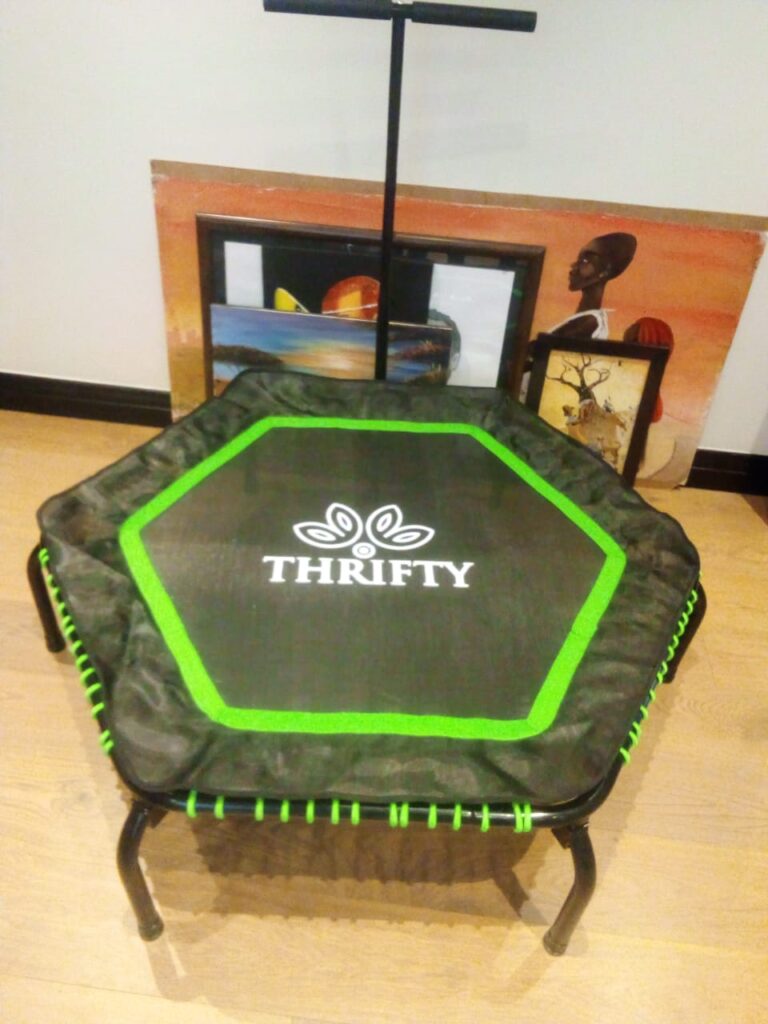Bouncing Back: How Trampolines Help in Postpartum Recovery Workouts

Childbirth is one of the most physically demanding experiences a woman can go through. In Kenya, like in many parts of the world, postpartum recovery is often underestimated, with limited focus on holistic fitness for new mothers. However, a surprising tool is gaining popularity among fitness-conscious Kenyan mums: the mini trampoline. Research reveals that postpartum trampoline workouts in Kenya can offer a safe, effective, and enjoyable way for mothers to regain strength, improve pelvic floor function, enhance cardiovascular health, and boost mental wellbeing after childbirth.
Visit our shop HERE to explore all our products
To order call: +254722724893
Email: info@thriftyent.com, thrifty.ent@gmx.com
The Postpartum Fitness Challenge in Kenya
Many Kenyan women face postpartum fitness challenges, including weakened core muscles, pelvic floor dysfunction, fatigue, and the emotional toll of hormonal shifts. Traditional exercise options like running or heavy gym routines may feel intimidating or physically unsuitable during early recovery months.
According to a study by Daley et al. (2008), gentle aerobic exercise significantly improves postpartum depression symptoms and physical recovery. However, the activity must be low-impact to prevent injury. This is where trampoline exercises after childbirth excel: they provide a unique combination of cardio, strength training, and balance work — all while being gentle on healing bodies.
How Trampoline Workouts Support Postpartum Recovery
1. Strengthening the Pelvic Floor and Core
One of the major concerns after delivery, especially after vaginal births, is the weakness of the pelvic floor muscles. A study in the British Journal of Sports Medicine highlights that rebounding (jumping lightly) can stimulate pelvic muscles without excessive strain (Bo et al., 2015).
Mini trampoline routines involve rhythmic, small movements that gently engage the pelvic muscles, abdominal wall, and lower back — all crucial for rebuilding core stability. Kenyan physiotherapists are increasingly recommending mini-trampoline exercises for new mums dealing with mild incontinence or diastasis recti (separated abdominal muscles).
2. Low-Impact Cardiovascular Fitness
Postpartum women often experience fatigue but need cardiovascular activity to rebuild stamina. NASA research famously showed that rebounding on a trampoline is 68% more efficient than running and produces lower joint impact (Bhattacharya et al., 1980). For new mothers in Kenya, who may have limited access to safe outdoor spaces or gyms, a trampoline at home offers an ideal indoor cardio option.
Moreover, bouncing improves lymphatic drainage, which aids in reducing postpartum swelling and enhances overall immune function — important for mothers recovering from the physical demands of delivery.
3. Mental Health Boost: Fighting Postnatal Depression
Postnatal depression is a significant concern in Kenya, affecting about 10–20% of new mothers according to WHO reports. Exercise is a proven natural remedy for improving mood by boosting endorphin levels (Daley et al., 2008).
Trampoline workouts combine physical movement with fun, rhythmic motion, promoting stress relief and mental clarity. A light 15–20 minutes of bouncing daily can significantly improve mood, helping mothers “bounce back” emotionally as well as physically.
4. Convenience and Safety
In Kenya’s busy urban setups like Nairobi, Mombasa, and Kisumu, new mums often juggle multiple responsibilities. Postpartum trampoline workouts Kenya offer a convenient way to fit in exercise at home without needing special equipment or long commutes. Compact trampolines can fit even in small apartments or compounds.
Plus, workouts can be easily modified based on individual recovery stages. Light bouncing, gentle squats, or simple balance drills are safe to start within 6–8 weeks postpartum (after medical clearance), making the trampoline a flexible fitness solution.
For Kenyan mothers looking to safely and efficiently regain strength, lose pregnancy weight, and lift their mood after childbirth, postpartum trampoline workouts Kenya offer an outstanding solution. They address not just physical recovery, but emotional wellness, while fitting easily into a busy lifestyle. As awareness grows, trampolines are quickly becoming a must-have fitness tool for postpartum recovery in Kenya — helping new mums bounce back, stronger and happier.
References
Bhattacharya, A., McCutcheon, E. P., Shvartz, E., & Greenleaf, J. E. (1980). Body acceleration distribution and O2 uptake in humans during running and jumping. Journal of Applied Physiology, 49(5), 881–887.
Bo, K., & Frawley, H. C. (2015). Exercise for the prevention and treatment of pelvic floor dysfunction in women: A systematic review. British Journal of Sports Medicine, 49(10), 689–695.
Daley, A. J., MacArthur, C., & Winter, H. (2008). The role of exercise in treating postpartum depression: A review of the evidence. The Journal of Midwifery and Women’s Health, 53(4), 316–322.
World Health Organization (WHO). (2022). Maternal mental health. Retrieved from www.who.int
- Where to Repair Trampolines in Kenya: Fast, Affordable, Professional Services by Frugal Innovations Kenya
- How to Safely Repair a Sun-Faded or UV-Damaged Trampoline Mat in Kenya
- Are Trampolines the Next Big Fitness Asset for Kenyan Women?
- How Nairobi’s Dust and Wind Patterns Affect Trampoline Lifespan — Best Trampoline Repairs in Kenya
- How to Start a Trampoline Hire Business in Nairobi — Costs, Earnings, Risks, Competition


